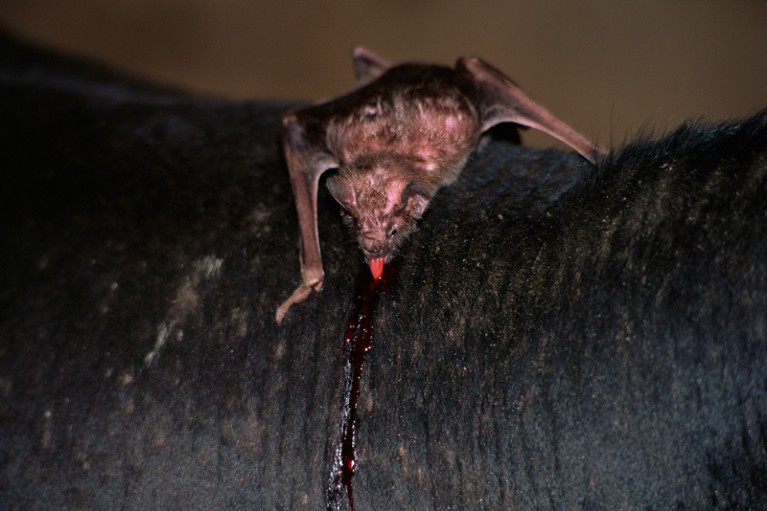
Credit: Jim Clare/Nature Picture Library
Latin American governments’ decades-long campaign of killing vampire bats to reduce rabies outbreaks has the opposite effect, a study in Peru has found. Reactive culling, which takes place after the disease is already present, can accelerate the spread of the virus, according to a paper published today in Science Advances1.
“We have to be very careful about applying these sorts of interventions to wild animal populations before we understand how those animal behavioural responses might alter virus transmission,” says study co-author Daniel Streicker, who is a infectious-disease ecologist at the University of Glasgow, UK.
Vampire bats (Desmodus rotundus) are considered pests of livestock such as cattle because they feed on animal blood. Although only a small amount of blood is taken, the bite wound is vulnerable to infection. A rabies-infected bat can transmit the disease, which ultimately kills the prey, harming farmers and their families financially. The infected bats also pose a public-health risk — few humans survive late-stage rabies. To reduce the spread of the disease, authorities use a deadly poison called vampiricide to decimate vampire-bat populations.
Streicker and his colleagues used infection rates in livestock and sequenced the genomes of rabies viruses collected from livestock before, during and after a two-year programme in three regions of Peru to model the policy’s effects. When bats were poisoned before rabies was detected in an area, the researchers found that the culling could slow the spread of rabies. This might be because fewer bats means fewer opportunities for virus transmission. But reactive culling had little benefit and even increased disease spread. They also found that culling didn’t reduce the numbers of dead livestock — once an outbreak had begun, the burden of disease was the same regardless of whether bats were killed. The finding counters the idea that reducing populations of vampire bats will help to limit rabies outbreaks.
Finding alternative solutions
“What they found is so important because it challenges this assumption that culling is the way to go,” says Elsa Cárdenas-Canales, a veterinarian researcher at the University of Wisconsin–Madison, who has previously worked with the researchers. She says that a more evidence-based approach could better limit disease spread. “It helps the rest of us [make] a case for finding alternative solutions.”
Reactive culling probably contributes to the spatial spread of rabies because it disturbs the bats in their roosts, causing infected bats to relocate. Rabies is an ephemeral disease that flares up from population to population, Streicker says, which means a bat community might already be on its way to recovery by the time an outbreak is identified and the local bats are killed — meanwhile, the virus slips away to another area.
“It’s a little bit like a forest fire, where you’re working on putting out the embers but not realizing that another spark has set off a forest fire in a different location,” says Streicker.
The study confirms earlier work2,3 that suggested that killing vampire bats does not reduce rabies spillover, although the current analysis uses more-extensive data and offers a more-comprehensive picture of the effects of culling, says Pejman Rohani, an epidemiologist at the University of Georgia in Athens, who has previously worked with the authors.
Because non-rabid vampire-bat bites can cause other infections, too, and therefore harm livestock, bat populations need to be controlled, says Streicker. But before any changes to the bat-culling policy are considered, he would like to see more research on rabies management, particularly developing disease-outbreak forecasting tools. Shifting toward preventative culling would help authorities to get ahead of outbreaks and control the virus’s spatial spread, he says. Combining preventive culling with other population- and disease-control methods — such as rabies vaccines or, in future, the control of bat birth rates — could further reduce the disease burden.

